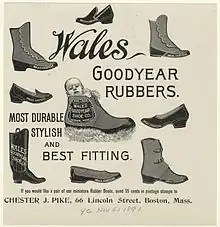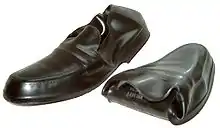Galoshes
Galoshes, also known by many other names, are a type of overshoe or rubber boot that is slipped over shoes to keep them from getting muddy or wet during inclement weather.
.png.webp)
Names
The English word galosh, golosh,[1][2][3] etc. comes from French galoche from Medieval Latin galopia, a variant of Late Latin calopes and calopedes, a partial calque of Greek kalopódion (καλοπόδιον) from kâlon (κᾶλον, "wood") + poús (πούς, "foot").[4] The calopedes of Late Antiquity were a kind of wooden clog and the name was occasionally reused in the Middle Ages for pattens, wooden bottoms strapped to softer shoes to allow outdoor use.[4] By the 14th century, galosh was also being used to refer to English-style clogs, shoes with a wooden sole and a full fabric or leather upper[5] and then to any shoe or boot generally,[2] a meaning it still bears in Azorean Portuguese.
From the patten definition, galosh ultimately took on its present meaning of an overshoe worn at sea or in inclement weather. As such, they are also known as overshoes or bad-weather shoes and, now that they are universally made from rubber or rubber-like plastic, may be called rubbers, rubber boots, or gumshoes. Especially in the United Kingdom, galoshes in the form of large rubber boots are known as Wellington boots.
A galosh that only wraps around a shoe's upper is known as a spat or gaiter. Among bootmakers, a galosh is also a piece of leather like a welt that runs around the top of the sole between it and the uppers. In Turkish contexts, galoş most often intends smaller overshoes that are worn indoors to keep from tracking mud or dirt onto the floor.[6]
History


The transition from a traditional wooden sole galosh to one of vulcanized rubber may be attributed to Charles Goodyear and Leverett Candee. The qualities of rubber, though fascinating to Goodyear, were highly dependent on temperature: it was tacky when hot, brittle when cold. Vulcanization of rubber tempered its properties so that it was easily molded, durable, and tough. A rubberized elastic webbing made Goodyear's galoshes (c. 1890) easy to pull on and off. Since the early 20th century, galoshes have been almost universally made of rubber.[2] Overshoes have evolved in the past decades and now are being made with more advanced features, such as high traction outsoles.

There are now three basic types of galoshes. The first is known in the United Kingdom as a Wellington boot, a large rubber boot. Another is slightly smaller, an oversize shoe or low boot made of thick rubber with a heavy sole and instep, also designed for heavy-duty use. The last is much thinner, of more flexible material, and more like a rubber slipper designed solely for protection against the wet and slips rather than for extensive walking.
References
Citations
- Victorian Research Login needed
- One or more of the preceding sentences incorporates text from a publication now in the public domain: Chisholm, Hugh, ed. (1911). "Golosh". Encyclopædia Britannica. Vol. 12 (11th ed.). Cambridge University Press. p. 226.
- "Galosh". Answers. 1970-01-01. Retrieved 2012-09-28.
- "golosh". Oxford English Dictionary (Online ed.). Oxford University Press. (Subscription or participating institution membership required.)
- William, Langland (c. 1377), "Passus XVIII", in Echmidt, A V C (ed.), The vision of Piers Plowman, London & Melbourne: Everyman (published 1984), line 14, ISBN 0-460-11571-5,
To geten him ... galoches ycouped.[slashed shoes]
- galoş (in Turkish) (Translate: Google, Bing, Yandex) Türk Dil Kurumu. TDK. 2019. Retrieved 11 July 2020. Note: Insert the word galoş in the translated search bar.
Bibliography
- Canizares, George. "Galosh Revolution." US Airways Attache (December 1998): 30.
- Lawlor, Laurie. Where Will This Shoe Take You? A Walk Through the History of Footwear. New York: Walker and Company, 1996.
- Moilliet, J. L., ed. Waterproofing and Water-Repellency. London: Elsevier Publishing Company, 1963.
- O'Keefe, Linda. Shoes: A Celebration of Pumps, Sandals, Slippers, & More. New York: Workman Publishing, 1996.
- Yue, Charlotte and David. Shoes: Their History in Words and Pictures. Boston: Houghton Mifflin Company, 1997.